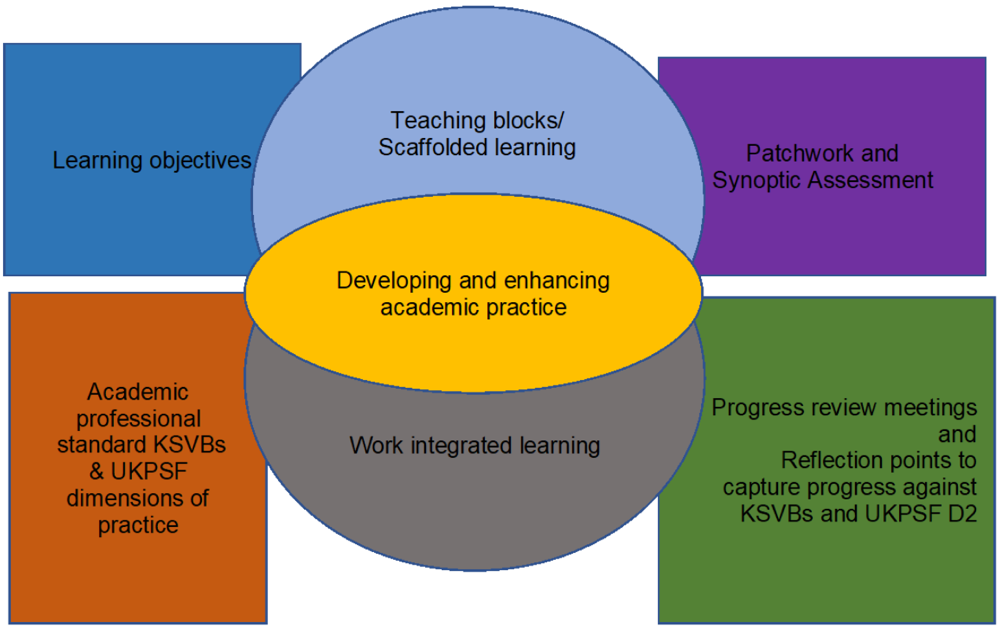Engaging and empowering early-career academics: an active learning curriculum design for the APA/PGCLTHE
Dr Bianca Fox; Dr Sandy Cope; Adam Tate; and Vicky Breckin
What is the idea?
This short chapter describes the interlinked pedagogical principles used to rethink the curriculum design of the Academic Professional Apprenticeship (APA)/Postgraduate Certificate in Learning and Teaching in Higher Education (PGCLTHE) course at Nottingham Trent University (NTU). Active learning was a key tenet of the redesign of the course. The focus was on engaging course participants in experiential learning, peer problem solving, and project-based learning, both synchronously and asynchronously. This chapter is particularly useful for course teams who want to redesign a course creatively. The curriculum design principles explored in this chapter would apply mainly to thin modules longer than one semester or one academic year.
Why this idea?
To inspire and enhance the teaching and learning practices of the students undertaking the APA/PGCLTHE course, active learning philosophies were embedded. In short, learners learn by doing, challenging, discussing, observing, and exploring different ways of teaching and learning in Higher Education. Adopting a teaching philosophy of active and participatory engagement, the general principles that guided the design and planning of the curriculum were as follows:
1. Chunking thin modules (year-long or longer) into smaller units of content that correspond to workplace activities and are directly mapped to the APA standard and UK Professional Standards Framework (UKPSF) dimensions of practice.
2. Scaffolded learning to support work-integrated learning opportunities and enable teaching of threshold concepts.
3. Reflection that improves and solidifies learning at the end of key teaching blocks coupled with tripartite meetings that track and capture learners’ progress against the course Learning Outcomes, APA Knowledge, Skills, Values and Behaviours (KSVBs), and the UKPSF dimensions of practice.
4. Synchronous and asynchronous active collaborative learning and peer support.
5. Assessment for learning: Designing patchwork assessment that supports learners to gather evidence and build towards the end point assessment.
The intention was to move away from a lecture-dominated knowledge transmission model of learning focused primarily on meeting the learning outcomes to a more flexible approach to curriculum design and delivery, which focuses on skills development through work-integrated learning. The planning and delivery of the curriculum are focused on developing skills and competencies through activities in the workplace, supported by off the job training and useful formative activities.
Knowledge previously organised in modules is now planned and delivered in teaching blocks designed through a process of triangulation between course learning outcomes, the APA standard (KSVBs), and UKPSF dimensions of practice and work-integrated learning. A teaching block is a constructed sequence of learning mapped and triangulated (see Figure 1) to a particular key theme so that learning is sequenced for the learner to build multiple skills and discover how to apply them. Through the consideration of constructive alignment (Biggs & Tang, 2011) we determined the content included in each teaching block, the teaching blocks included in each module and how progress will be measured. According to Biggs (2003, p. 2) learners “construct meaning through relevant learning activities” which are focused on the end goal and the “desired learning outcomes”. However, unlike Biggs’ cohesive outcome-focused model, our curriculum model focuses on internalising learning outcomes and developing critical self-governing academics who understand the value and impact of their teaching and will continue to engage in CPD beyond the course.

Learning is scaffolded in each teaching block, allowing for logical progression from simplistic to more complex concepts, theories and ideas and enabling learners to transfer the knowledge and skills gained in each block to the workplace. Each session is mapped against the APA Standard and UKPSF dimensions of practice at D2, and learners are supported to apply the knowledge gained on the course in their own practice, with support from peers, workplace mentors and line managers. Key concepts and theories were selected using the threshold concept theory (Meyer & Land, 2003) coupled with the needs of the learners and employers. Threshold concepts are defined as “concepts that bind a subject together, being fundamental to ways of thinking and practicing in the discipline” (Land, Cousin, & Meyer 2005, p. 54). Through discussions with learners, line managers, mentors, and employers, we created a diverse and collaborative curriculum model that includes multiple perspectives, but more importantly helps to promote professional, social and ethical values and behaviours. This makes teaching on the APA/PGCLTHE learner-centred, inclusive, and contextualised within the workplace.
Our teaching blocks are designed not only to provide the learners with relevant learning experiences, but also to ensure that key concepts and theories can be confidently applied in their classroom with their own students. This approach is supported by an academic mentor and a workplace mentor within their School who assists the learner to complete the blocks through activities within their own School. Throughout the course, all learners are expected to participate in tripartite meetings, which are attended by the learner, a member of staff from the Academic Practice team and a Workplace Mentor from their school. These meetings take place 4x a year and, 6x in total throughout the full duration of the course. The purpose of these meetings is to monitor progress towards the End Point Assessment, to further support learners to make links to the KSVBs and achieve the learning outcomes of the course. The tripartite meetings are also an opportunity to review, feedback and reflect on all aspects of the learning journey. In the context of active collaborative learning, these meetings help to widen the learning community, by supporting students to translate their learning to the workplace and to recognise and identify new opportunities to further develop the KSVBs and apply threshold concepts within their roles. These meetings are also an excellent way of linking to other support channels – for instance other peers on the course, previous course participants, other colleagues who have particular areas of expertise, working groups, forums etc. Action planning is key to a successful tripartite meeting. This is a collaborative process, where targets are agreed, set and reviewed in future meetings, installing a sense of accountability and ensuring important information discussed in meetings is not lost. The value of tripartite meetings increases over time as learners progress, however positive outcomes of these meetings rely on all parties being engaged and invested in the process.
Lastly, the new redesigned course offers opportunities for both patchwork and synoptic assessment to enable knowledge transfer and support learners to make connections between modules, and to understand the relevance and application of the content taught. Patchwork assessment was designed for each module that feeds into the overarching synoptic end point assessment. The rationale behind this assessment strategy is two-fold: first, to assess work against the learning outcomes, the APA Standard and UKPSF and second, to allow learners to undertake experiential learning through formative work-based learning assessment techniques, which form the basis of an authentic assessment experience.
How could others implement this idea?
Any course with long, thin modules could be redesigned using our proposed curriculum design principles.
1. Start by working with your team on identifying threshold concepts.
2. Chunk long thin modules into smaller units of content that enable learners to explore and apply threshold concepts whilst at the same time meet the learning outcomes of the module. (Remember that chunks should ideally be between 5-8 sessions).
3. Consider how to scaffold learning to support learners to apply what they learn on the course either in practical sessions that simulate real-world pressures and deadlines or in the workplace (e.g. Work placement modules). Incorporate active learning strategies and formative authentic assessment opportunities.
4. Embed reflection in your course. Think of key points in your students’ learning journey when they should pause and reflect on their progress and on what they want to achieve next.
5. Assign students to peer support groups from the start of your course and design synchronous and asynchronous active learning activities to encourage them to work in peer support groups.
6. Use assessment for learning principles. Design patchwork assessment to support your students to work towards completing the summative assessment.
Transferability to different contexts
This idea is relevant to all course leaders and module leaders that have to design and deliver year-long or longer modules. The idea would be particularly useful for those designing and delivering courses that need to meet a number of professional frameworks, such as Academic Practice courses.
Links to tools and resources
Academic Professional Apprenticeship Standard: https://www.instituteforapprenticeships.org/apprenticeship-standards/academic-professional/
UK Professional Standards Framework: https://www.advance-he.ac.uk/guidance/teaching-and-learning/ukpsf
References
Biggs, J.B. (2003). Teaching for quality learning at university. Open University Press/Society for Research into Higher Education.
Biggs, J., & Tang, C. (2011). Teaching for Quality Learning at University: What the student does (4th ed.). Open University Press.
Land, R., Cousin, G., & Meyer, J.H.F. (2005). Threshold Concepts and Troublesome Knowledge (3): Implications for Course Design and Evaluation. In C. Rust (Ed.), Improving Student Learning Diversity and Inclusivity (pp. 53–64). The Oxford Centre for Staff and Learning Development.
Meyer, J.H.F., & Land, R. (2003). Threshold concepts and troublesome knowledge: Linkages to thinking and practice within the Disciplines. ETL Project. Occasional Report 4, May 2003. http://www.etl.tla.ed.ac.uk/docs/ETLreport4.pdf
Image Attributions
Figure 1. APA/PGCL THE work-integrated Learning Curriculum Model by Bianca Fox, Sandy Cope, Adam Tate and Vicky Breckin is used under CC-BY 4.0 Licence



